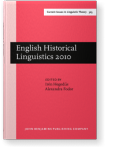“No man entreth in or out”
How are typologically unsuitable loanverbs integrated into English?
English motion verbs typically encode the manner of motion (e.g. run, walk, cf. e.g. Talmy 2000: 27, Slobin 2004). This raises the question of how French- and Latin-borrowed motion-verbs such as enter, descend, that express the path of motion and therefore are typologically ‘unsuitable’ for English, are integrated into this language. Based on a detailed analysis of the occurrences of enter in PPCME2 and CEECS, and drawing on ideas from studies in second language acquisition and cognitive linguistics, it will be shown that on the one hand, enter has a strong tendency to be used non-literally, i.e. for situations where the figure or goal are not concrete or visually perceivable; in its literal uses, on the other hand, it will be argued to bear additional manner-meaning. Both findings can be explained by the verb being a semantic misfit among English motion verbs. Similar usage patterns will be shown to apply to other borrowed path-verbs.
Cited by (1)
Cited by one other publication
Fanego, Teresa
2017.
The trolley rumbled through the tunnel: On the history of the English Intransitive Motion Construction.
Folia Linguistica 51:s38-s1
► pp. 29 ff.

This list is based on CrossRef data as of 13 july 2024. Please note that it may not be complete. Sources presented here have been supplied by the respective publishers.
Any errors therein should be reported to them.
